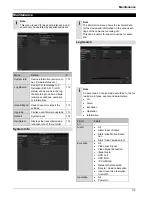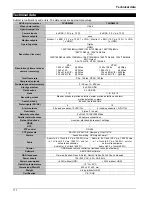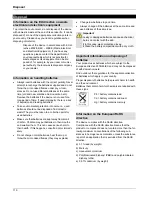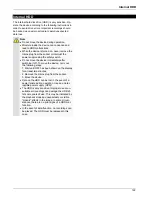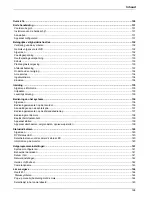
Disposal
119
Disposal
Information on the EU directive on waste
electrical and electronic equipment
To protect the environment, do not dispose of the device
with domestic waste at the end of its service life. It can be
disposed of at one of the appropriate collection points in
your country. Please obey your local regulations when
disposing of material.
Dispose of the device in accordance with EU di-
rective 2002/96/EC – WEEE (Waste Electrical
and Electronic Equipment). If you have any
questions, please contact the department of
your local authority which is responsible for
waste disposal. Used equipment can be dis-
posed of, for example, by your local or munici-
pal authority, the local waste disposal company
or your dealer.
Information on handling batteries
Always insert batteries with the correct polarity. Never
attempt to recharge the batteries supplied and do not
throw them into naked flames under any circum-
stances. Do not use different batteries at the same
time (old and new, alkaline and zinc-carbon etc.).
Remove the batteries if the device is not used for a
long period of time. If used improperly, there is a risk
of explosion and leaking batteries!
Take environmental protection into account – used
batteries should not be disposed of in domestic
waste! They must be taken to a collection point for
used batteries.
Make sure that batteries are kept away from small
children. Children may put batteries in their mouths
and swallow them. This can cause serious harm to
their health. If this happens, consult a doctor immedi-
ately.
Do not charge normal batteries, heat them up or
throw them into naked flames (they may explode).
Change low batteries in good time.
Always change all the batteries at the same time and
use batteries of the same type.
Important
Leaky or damaged batteries can cause chemical
burns on contact with the skin.
In this case, wear protective gloves.
Clean the battery compartment with a dry cloth.
Important information on disposing of
batteries
Your product uses batteries which are subject to the
European directive 2006/66/EC and may not be disposed
of with domestic waste.
Find out about the regulations for the separate collection
of batteries which apply in your country.
Proper disposal of batteries helps prevent harm to health
and the environment.
Batteries that contain harmful chemicals are labelled with
these signs:
Pb = battery contains lead
Cd = battery contains cadmium
Hg = battery contains mercury
Information on the European RoHS
directive
The device complies with the RoHS directive.
Compliance with the RoHS directive means that the
product or component does not contain more than the fol-
lowing maximum concentrations of the following sub-
stances in homogeneous materials, unless the substance
is part of an application that is excluded from the RoHS
directive:
a) 0.1% lead (by weight)
b) Mercury
c) Hexavalent chromium
d) Polybrominated biphenyl (PBB) and polybrominated
diphenyl ether
e) 0.01% cadmium (by weight)
Summary of Contents for TVHD800x0
Page 4: ...Ger te bersicht 4 Fernbedienung TVAC40930 optional erh ltlich...
Page 64: ...ABUS HD SDI recorder TVHD800x0 User manual Version 1 2...
Page 67: ...Device overview 67 Remote control TVAC40930 optional available...
Page 124: ...ABUS HD SDI recorder TVHD800x0 Gebruikershandleiding Version 1 2...
Page 127: ...Overzicht 127 Afstandsbediening TVAC40930 optioneel beschikbaar...
Page 184: ...ABUS Enregistreur HD SDI TVHD800x0 Manuel d utilisateur Version 1 2...
Page 187: ...Vue d ensemble de l appareil 187 T l commande TVAC40930 disponible en option...
Page 244: ...ABUS HD SDI optager TVHD800x0 Brugerh ndbog Version 1 2...
Page 247: ...Oversigt over apparatet 247 Fjernbetjening TVAC40930 kan ogs v lges...
Page 304: ...Nagrywarka cyfrowa ABUS HD SDI TVHD800x0 Instrukcja obs ugi Wersja 1 2...
Page 307: ...Przegl d urz dzenia 307 Pilot TVAC40930 dost pny jako opcja...








